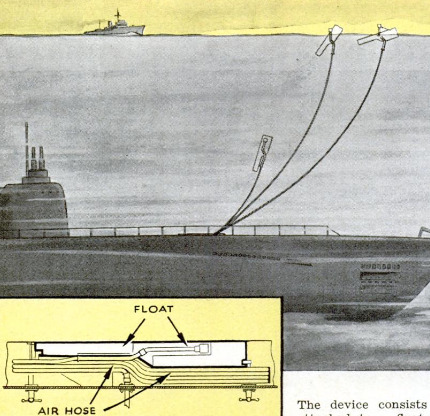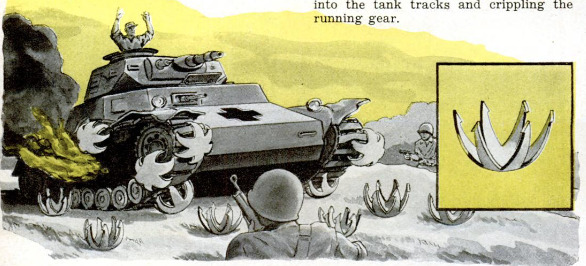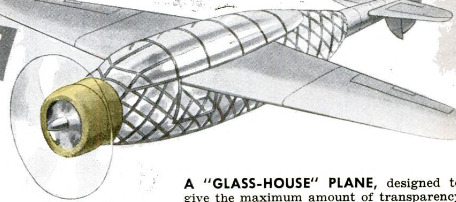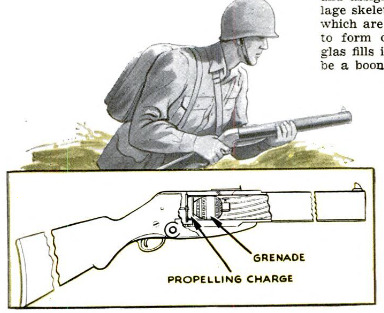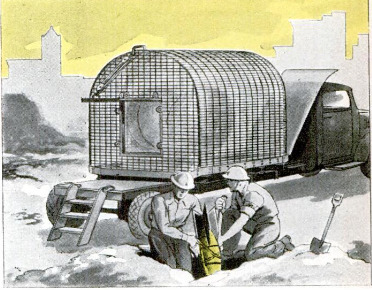War Ideas
Item
-
Title (Dublin Core)
-
War Ideas
-
Article Title and/or Image Caption (Dublin Core)
-
War Ideas
-
extracted text (Extract Text)
-
SUBMARINES CAN BREATHE with this air-
supply conduit invented by Frederick Gray, of
Cheltenham, England. Occupants of the sub-
merged vessel can release the apparatus when
it would be too dangerous to surface the craft.
The device consists of a flexible hose
attached to a float which rises to the
surface when the conduit is set free. In
addition to providing an air line, the ap-
paratus might be used as a means of in-
dicating the location of a submarine
trapped on the ocean floor, or even afford
a means of communication with the crew
from rescue vessels on the surface.
CALTROPS, spiky steel stars which were
strewn on ancient battlefields to impede cav-
alry, have a modern counterpart in a device
proposed by William J. McDonald, of Kansas
City, Mo., for use against tanks. Cuplike stars,
each having six barbed points, would be
stamped from heavy steel sheets or plates.
Planted in the path of enemy tanks, they
would rock on their curved bottoms when
rolled upon, jamming their barbed spikes
into the tank tracks and crippling the
running gear.
A ““GLASS-HOUSE" PLANE, designed to
give the maximum amount of transparency
compatible with good design, has been pat-
ented by R. W. Palmer, of Whittier, Cal,
and assigned to Vultee Aircraft. Its fuse-
lage skeleton is a framework of metal ribs,
which are arranged in a crisscross pattern
to form diagonally spaced panels. Plexi-
glas fills in the openings. The plane would
be a boon to photographers and observers.
A GRENADE GUN, looking
very much like the blunder-
buss of old except for the ab-
sence of a flaring muzzle, is the
invention of S. D. Long, of
Laurel, Md. The weapon is rifled
along the bore, which is big
enough across to accommodate
the average hand grenade. Gre-
nades for the gun are ribbed to
take the grooves along the bore,
imparting greater accuracy in
flight. Propulsion for the gre-
nade is accomplished by a small
powder charge.
THIS BOMB-REMOVER is
the brainchild of Fiorello H.
LaGuardia, New York's may-
or; Thomas Rochester, of
Tuckahoe; Hyman Barron, of
Laurelton; and John Gibala,
of Little Neck, N. Y. Its
novel feature is the strong
steel-mesh enclosure for hous-
ing an unexploded time bomb
or other infernal machine, so
that a premature explosion
will cause little damage.
Spherical inner and outer ex-
plosion chambers are pro-
vided, as well as a support for
the explosive at the center of
the container. The apparatus
was designed to cut down the
pressures of explosive gases,
which travel radially.
-
Language (Dublin Core)
-
eng
-
Date Issued (Dublin Core)
-
1943-10
-
pages (Bibliographic Ontology)
-
88-89
-
Rights (Dublin Core)
-
Public Domain (Google digitized)
-
Archived by (Dublin Core)
-
Matteo Ridolfi
-
Alberto Bordignon (Supervisor)
 Popular Science Monthly, v. 143, n. 4, 1943
Popular Science Monthly, v. 143, n. 4, 1943

